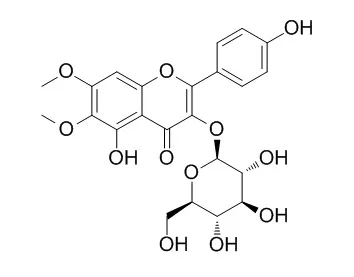| Structure Identification: |
| Phytochemical Analysis, 2005, 16(6):451-458. | | Characterisation of the phenolic profile of Boerhaavia diffusa L. by HPLC-PAD-MS/MS as a tool for quality control.[Reference: WebLink] |
METHODS AND RESULTS:
Phenolic acids and flavonols of nine leaf and three root samples of Boerhaavia diffusa L., collected at different locations and subjected to several drying procedures, were characterised by reversed-phase HPLC-PAD-ESI/MS for the first time. Ten phenolic compounds were identified: 3,4-dihydroxy-5-methoxycinnamoyl-rhamnoside, quercetin 3-O-rhamnosyl(1-->6)galactoside (quercetin 3-O-robinobioside), quercetin 3-O-(2"-rhamnosyl)-robinobioside, kaempferol 3-O-(2"-rhamnosyl)-robinobioside, 3,5,4'-trihydroxy-6,7-dimethoxyflavone 3-O-galactosyl(1-->2)glucoside [eupalitin 3-O-galactosyl(1-->2)glucoside], caffeoyltartaric acid, kaempferol 3-O-robinobioside, eupalitin 3-O-galactoside(Eupalitin 3-galactoside), quercetin and kaempferol. Quantification was achieved by HPLC-PAD and two phenolic patterns were found for the leaves, in which quercetin 3-O-robinobioside or quercetin 3-O-(2"-rhamnosyl)-robinobioside was the major compound. Caffeoyltartaric acid was only present in the root material where it represented the main phenolic constituent.
CONCLUSIONS:
The results obtained demonstrated that the geographical origin (particularly the nature of the soil), but not the drying process, influences the phenolic composition. |
|






 Cell. 2018 Jan 11;172(1-2):249-261.e12. doi: 10.1016/j.cell.2017.12.019.IF=36.216(2019)
Cell. 2018 Jan 11;172(1-2):249-261.e12. doi: 10.1016/j.cell.2017.12.019.IF=36.216(2019) Cell Metab. 2020 Mar 3;31(3):534-548.e5. doi: 10.1016/j.cmet.2020.01.002.IF=22.415(2019)
Cell Metab. 2020 Mar 3;31(3):534-548.e5. doi: 10.1016/j.cmet.2020.01.002.IF=22.415(2019) Mol Cell. 2017 Nov 16;68(4):673-685.e6. doi: 10.1016/j.molcel.2017.10.022.IF=14.548(2019)
Mol Cell. 2017 Nov 16;68(4):673-685.e6. doi: 10.1016/j.molcel.2017.10.022.IF=14.548(2019)